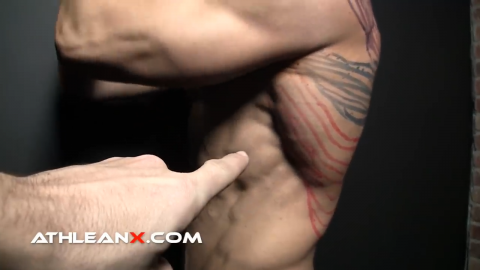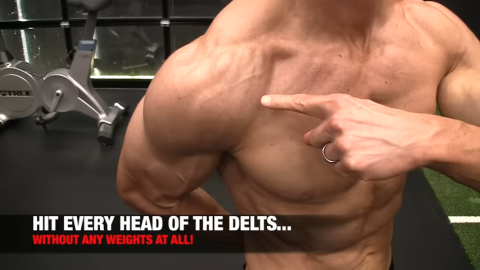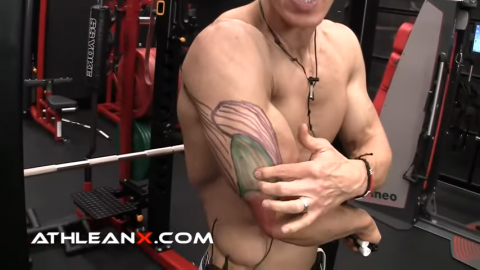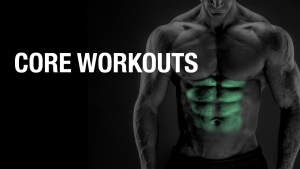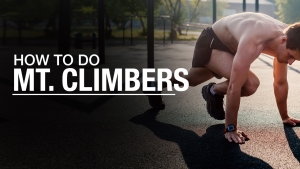
HOW TO USE AN AB ROLLER CORRECTLY
Today, we’re tackling one of the best ab exercises: the Ab Rollout.
The Ab Rollout is like a supercharged Plank.
Why?
Because it demands even more core stability.
While your abs do flex the spine, their primary function is to stabilize it. The Ab Rollout prevents back extension and controls rotation, working with your obliques to keep everything tight.
It’s an amazing core strengthener but diving into a version you’re not ready for can lead to injury.
I’ll show you how to master this exercise. And whether you’re a beginner or an advanced athlete, I have a progression for you.
Let’s break it down and get you rolling!
AB ROLLER: MUSCLES WORKED
To get the most out of the ab roller product, you need to nail that mind-to-muscle connection.
When you roll out, don’t just go through the motions. Focus on engaging your entire core—rectus abdominis, transverse abdominis, and obliques.
This is where real gains are made.
Talk to personal trainers and they’ll tell you that to really activate those core muscles, you have to feel every inch of the movement.
Don’t just train harder—train smarter.
With the right focus, you can take your core workout gadget to the next level and build critical core strength with every roll.
Ready to make those abs pop? Let’s get to work.
Here are the major muscle groups that are involved when you use an ab roller:
CORE
When you use the ab roller, it’s all about hitting those core and abdominal muscles hard.
We’re talking about activating your rectus abdominis, transverse abdominis, and obliques.
Every roll-out and return should light up your entire core, making it a killer workout for serious strength and stability.
RECTUS ABDOMINIS


The rectus abdominis is the star player when it comes to using the ab roller. This is the muscle you see when you think of a rippling six-pack.
It’s not just about the ‘upper abs’ or ‘lower abs‘—they’re all part of the same rectus abdominis muscle that spans from your ribcage down to your pelvis.
When you’re rolling out with an ab roller, you’re engaging this muscle to its fullest.
Your rectus abdominis fibers run vertically, providing critical core strength and stability during your core workout.
EXTERNAL OBLIQUES

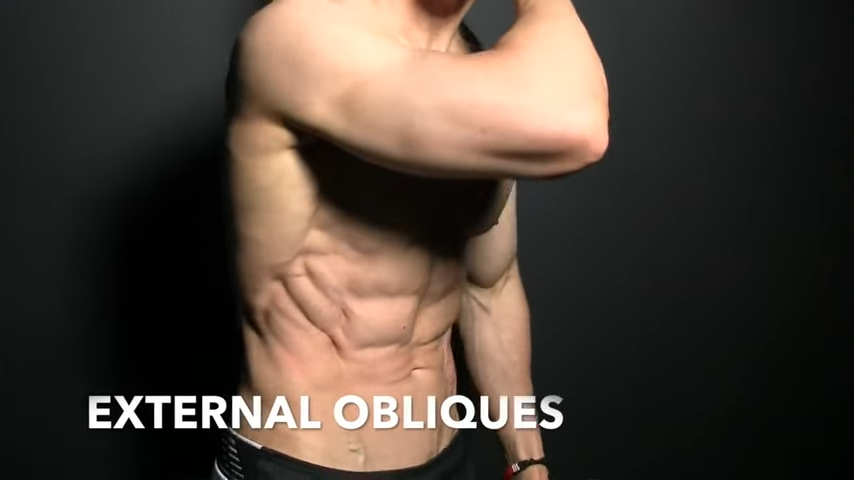
The external obliques are the diagonal fibers running from your ribcage down to your pelvis, crucial for rotation and stabilization.
When using the core ab roller, these muscles frame your rectus abdominis, enhancing your six-pack and boosting core strength.
Engaging your external obliques correctly ensures proper form and prevents injury.
INTERNAL OBLIQUES

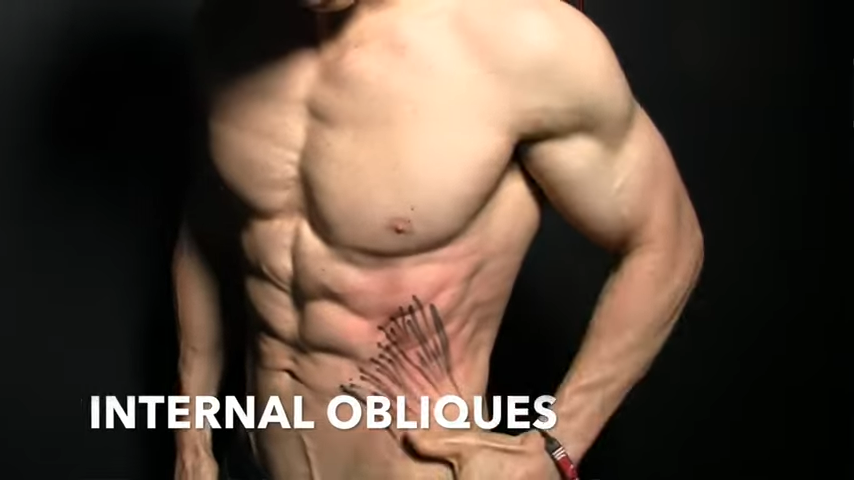
The internal obliques run opposite to the external obliques, from your ribcage to your hips, and angle toward your body’s midline.
These muscles are essential for core tension and stability during your core workout with the core ab roller.
Engaging your internal obliques correctly prevents form errors and maximizes workout effectiveness.
Whether you’re using ab roller on a yoga mat or exercise mat, these muscles keep your core tight and your position strong.
TRANSVERSE ABDOMINIS (CORE STABILIZER MUSCLES)


The transverse abdominis is your body’s natural weight belt, wrapping around your waist as one of the deepest core stabilizers.
Engage this muscle by drawing in your abs or doing ab vacuums to maintain core tension and stability during your core workout with the ab roller.
Targeting the transverse abdominis in your workouts improves core strength, athletic performance, and overall stability.
SERRATUS

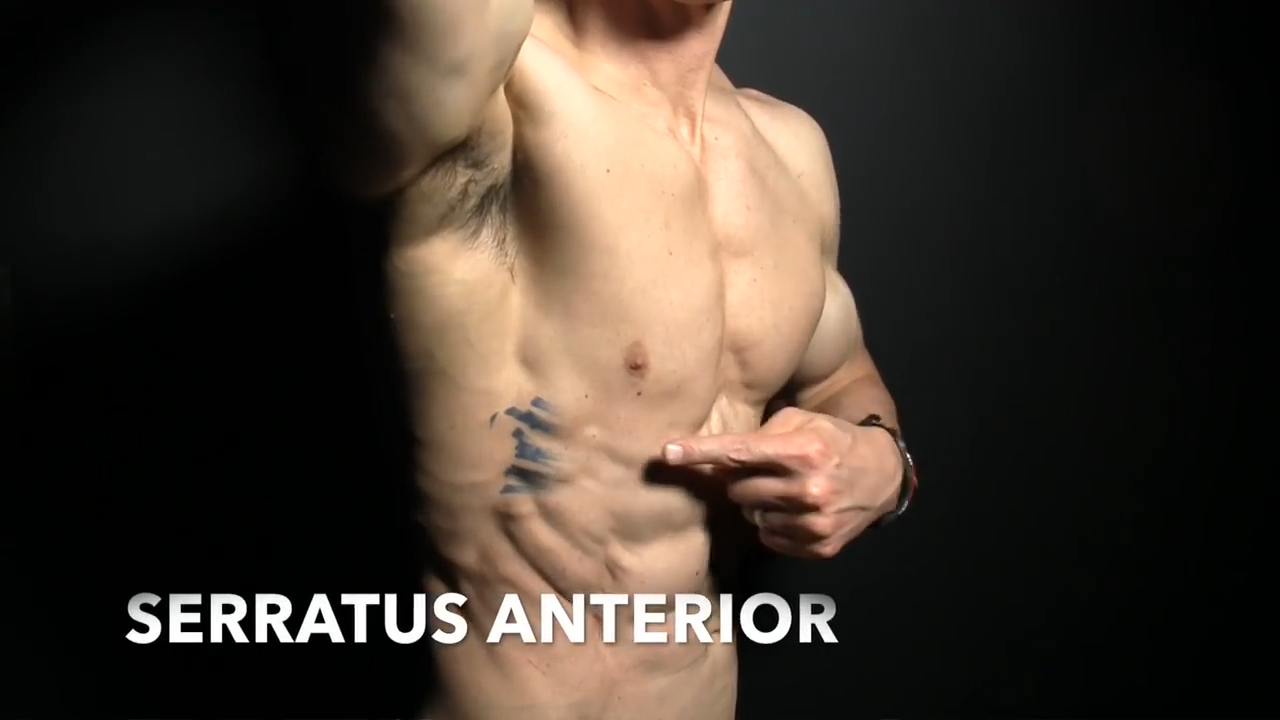
The serratus anterior is an often-overlooked muscle during core workouts.
Yet this muscle stabilizes the trunk by keeping the shoulder blades connected to the rib cage, crucial for maintaining a strong core during exercises.
Working the serratus anterior enhances shoulder health and upper body stability. Proper engagement prevents form errors and boosts performance in core workouts and sports.
HIP
Don’t overlook your hip flexors during your core workout—they’re crucial.
PSOAS


The psoas muscle, an important hip flexor muscle, is vital for core workouts with the ab roller.
Originating from the lumbar vertebrae and inserting into the femur, it plays a crucial role in maintaining form and stability.
When using the ab roller, the psoas helps keep your core tight and supports a neutral position, preventing injury during high-intensity exercises.
BACK
Sure, using an ab roller primarily targets your core, but you back also plays a role in stabilization.
LATISSIMUS DORSI
The lats – or latissimus dorsi muscles – are the heavy hitters of your back.
These muscles start from your spine and attach to your upper arm bone, helping with shoulder extension, adduction, and internal rotation.
They span your lower and mid-back, giving you that impressive “wing-like” look.
When using the core ab roller, your lats play a crucial role in maintaining core strength and stability.
During your core workout, your lats assist in controlling the movement, especially as you roll out and back.
To effectively engage your lats when using an ab roller, use a yoga mat with a knee pad for comfort.
Keep your core tight and maintain proper form with the roller handles to ensure a full range of motion.
SHOULDERS
While not the primary muscle, your shoulders – specifically the front delts and rotator cuff muscles – play a crucial supportive role when using the ab roller.
They help stabilize your upper body, ensuring a smooth and effective roll-out.
FRONT DELT (ANTERIOR DELTOID)
The front deltoids, or anterior delts, originate from the lateral third of the clavicle and attach to the deltoid tuberosity of the humerus.
These muscles are key for shoulder flexion, lifting your arm in front of your body, and also help with medial rotation and horizontal adduction.
When using the ab roller, your front delts play a supportive role.
They help stabilize your upper body and maintain a strong, controlled roll-out. This ensures you get the most out of your core workout, enhancing core strength and stability.
To effectively engage your anterior deltoids, keep your arms straight and strong, using the roller handles for stability.
ARM
Don’t forget about your triceps when using the ab roller.
These muscles, located on the back of your upper arm, help to stabilize your arms during the roll-out and return.
LATERAL HEAD OF TRICEPS
The lateral head of the triceps, located on the outer part of your upper arm, is crucial for upper body strength and muscle definition.
It originates from the humerus and inserts into the olecranon process of the ulna, contributing to the triceps’ overall mass and power.
When using the ab roller, the lateral head is key for stabilizing your arms during the roll-out and return, ensuring you maintain proper form.
Its primary function is elbow extension, making it essential for exercises that require arm straightening.
MEDIAL HEAD OF TRICEPS
The long head of the triceps is a powerhouse for building triceps size and strength.
It starts at the scapula’s infraglenoid tubercle and attaches to the ulna’s olecranon process, playing a crucial role in your arm’s overall power.
When using the ab roller, the long head is crucial for both elbow extension and shoulder extension, helping to straighten and move your arm backward.
This muscle plays a role in maintaining stability and power during your core workout.
HOW TO USE AN AB ROLLER
I’m going to take you from the most beginner-friendly version of how to use an ab roller, progressively working our way up to the most advanced version.
It starts with mastering the Plank. Remember, guys, I talked about this being an advanced version of a Plank.
The difference?
You’re dynamically moving into the position, not just holding it.
When using the Ab Wide Wheel, your contact with the ground is minimal compared to the full surface area of your forearms in a plank.
This means more balance is required, and the force is shifted to your upper body and core. You’re relying less on your forearms and more on your core and upper body strength.
So, make sure you’ve got a solid plank before moving on to the rollout.


HOW TO DO A PLANK:
- Get on the floor with your elbows directly under your shoulders. Place your forearms on the floor parallel to each other, palms facing down. For added comfort, use a yoga mat.
- Tighten your entire core region as if bracing for a punch. This will stabilize your body and maximize core strength.
- Stretch your legs out behind you, with your toes planted on the ground. Maintain a straight alignment from your head to your heels, avoiding any sagging or arching of your back.
- Hold your body tight. Your core functions to keep your spine neutral, preventing any sagging or rotation. This is a core challenge, so focus on keeping your core tight throughout.
- Don’t forget to breathe! Controlled, steady breaths will help you maintain the plank longer.
- Start with short holds and gradually increase as your core strength improves. Aim for 60 seconds. If you can hold a perfect Plank for more than 60 seconds, it’s time to move on to the next exercise.
WHAT MAKES IT EFFECTIVE: The plank is effective as a core exercise because it engages and stabilizes the entire core region, building critical strength and endurance without dynamic movement.
Once you’ve perfected your Plank exercise, you can move to the next progression of the exercise called the Physio Ball Stir.
PHYSIOBALL STIR


HOW TO DO A PHYSIOBALL STIR:
- Position yourself in a plank with your forearms resting on a stability ball, ensuring your body forms a straight line from head to heels.
- Tighten your entire core to stabilize your body. This is crucial for maintaining balance and maximizing the exercise’s effectiveness.
- Using your forearms, start drawing small circles on the ball. Keep the circles controlled and smooth.
- As you get stronger, make the circles larger. This will add more challenge to your core and stability.
- Ensure you work both directions. Perform circles clockwise and then counterclockwise to ensure balanced muscle engagement.
- Keep your body straight and core tight throughout the exercise to avoid any sagging or arching of the back.
WHAT MAKES IT EFFECTIVE: Physioball Stirs are effective as a core exercise because the instability of the ball forces continuous engagement and stabilization of the entire core, enhancing strength and balance.
Feeling good with the Physio ball Stir? Let’s move on to the next challenging progression:
PHYSIOBALL ALPHABET


HOW TO DO A PHYSIOBALL ALPHABET:
- Begin in a plank pose with your forearms placed on a stability ball, maintaining a straight alignment from your head to your heels.
- Tighten your core muscles to maintain stability and balance on the ball.
- Using your forearms, start drawing the letters of the alphabet on the ball. Begin with small, controlled movements. Each letter involves quick angle changes, which will challenge your core stability.
- Focus on making the movements precise and controlled, without rolling out fully. This ensures your core remains engaged and stable throughout the exercise.
- Go through the entire alphabet, ensuring you tackle various angles and directions to fully engage and challenge your core muscles.
WHAT MAKES IT EFFECTIVE: This exercise is effective because the unpredictable letter formations demand continuous core engagement and adaptability, enhancing overall core strength and stability.
At this point, you’re getting closer to a traditional Ab Wheel Rollout, but there’s one more exercise that I want you to master:
PHYSIOBALL ROLLOUT

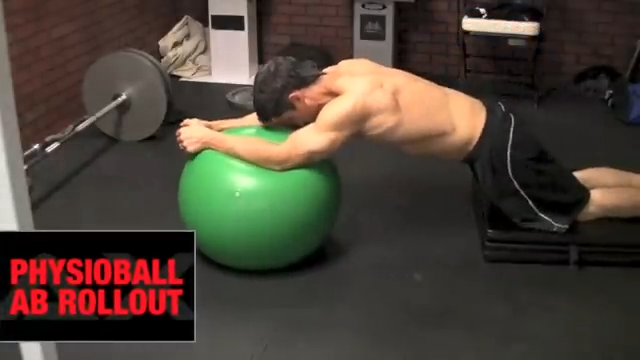
HOW TO DO A PHYSIOBALL ROLLOUT:
- Start by kneeling on the ground with the stability ball positioned in front of you. Position your forearms on the ball, ensuring that your elbows are aligned directly beneath your shoulders.
- Tighten your core muscles to stabilize your body and maintain a straight line from your knees to your head.
- Extend your arms and gradually push the ball forward, letting your body follow while maintaining tight core engagement. The further you roll out, the more challenging the exercise becomes due to increased gravitational force on your body angle.
- go as far as you can while maintaining control and proper form. Do not allow your back to sag or arch.
- Slowly pull the ball back towards your knees by flexing your arms and engaging your core, returning to the starting position.
- Start with small rollouts and gradually increase the distance as your strength improves. Staying higher off the ground will make the exercise easier; as you progress, you can lower your body for a greater challenge.
WHAT MAKES IT EFFECTIVE: The Physio ball Rollout effectively targets your core by increasing the demand for stabilization and strength as you extend and retract your body, enhancing overall core endurance and control.
Okay, now it’s time for you to get started with the Ab Wheel Rollout.
You can use entry-level ab wheels that have single or dual wheels for this exercise.
AB WHEEL ROLLOUT

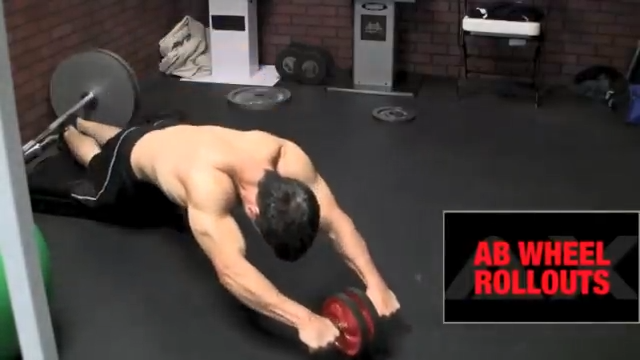
HOW TO DO AN AB WHEEL ROLLOUT:
- Begin on your knees with the ab wheel handles firmly in your hands. Your knees should be on a knee pad or a yoga mat.
- Tighten your core muscles to stabilize your spine. This is crucial for maintaining proper form and preventing lower back extension.
- Gradually push the wheel forward, extending your arms while maintaining a tight core. Roll out as far as possible without letting your lower back sag or arch, keeping your body in a straight line from knees to head.
- When you reach your maximum extension, pause briefly, keeping your core fully engaged. This will maximize the anti-extension benefits of the exercise.
- Gradually pull the wheel back towards your knees, using your core muscles to control the motion. Maintain a straight back and decent core engagement throughout the exercise.
- Start with small rollouts and gradually increase the distance as your strength improves. The key is maintaining control and proper form throughout the movement.
WHAT MAKES IT EFFECTIVE: Remember, this is an anti-extension movement. Your goal is to keep your body from arching into extension. Focus on keeping your core tight and your movements controlled for maximum effectiveness and safety.
AB WHEEL ROLLOUT (MULTI-DIRECTIONAL)


HOW TO DO A MULTIDIRECTIONAL AB WHEEL ROLLOUT:
- Begin on your knees with the easy-grip handles firmly in your hands.
- Tighten your core muscles to stabilize your spine. This is crucial for maintaining proper form and preventing lower back extension.
- First, roll the wheel straight out in front of you. Extend your arms and keep your core tight, ensuring your body forms a straight line from your knees to your head.
- Slowly roll the wheel back to the starting position, using your core to control the movement.
- Next, roll the wheel out to your right side. Again, extend your arms and maintain a tight core. This diagonal movement will engage your obliques more intensely.
- Bring the wheel back to the starting position with controlled movement.
- Finally, roll the wheel out to your left side. Keep your core tight and control the movement, engaging the opposite set of obliques.
- Slowly return to the starting position, completing one full cycle.
WHAT MAKES IT EFFECTIVE: By dynamically changing directions, you significantly increase the difficulty and effectiveness of the exercise. This multi-directional rollout not only challenges your core stability but also enhances your ability to control and stabilize your body during complex movements.
BARBELL ROLLOUT

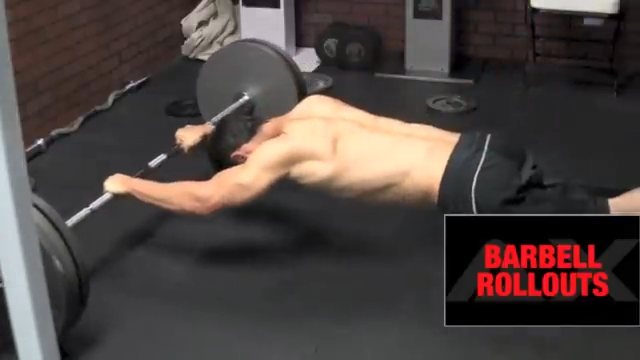
HOW TO DO A BARBELL ROLLOUT:
- Load a barbell with 45-pound plates (or more if you’re advanced). Position the barbell on the floor in front of you.
- Kneel down behind the barbell with your knees on a knee pad or yoga mat for comfort. Grip the barbell just outside shoulder width, ensuring a firm hold.
- Gradually push the barbell forward, fully extending your arms while keeping your core engaged. Ensure your body stays aligned in a straight line from knees to head, feeling the friction and weight as you advance.
- Go as far as you can without allowing your lower back to sag or arch. Maintain control and keep your core engaged throughout the movement.
- Now, the challenging part. Overcome the friction and weight to pull the barbell back towards your knees. Focus on generating enough force to change the bar’s direction while keeping your lower back in an anti-extended position.
- Throughout the movement, concentrate on keeping your core tight and your back straight. The goal is to generate force and control without flexing the spine.
WHAT MAKES IT EFFECTIVE: The Barbell Rollout is an excellent way to add intensity to your core workouts. By introducing the force of friction and weight, you significantly increase the demand on your core muscles, making it a perfect exercise for those looking to push their limits.
AB ROLLER: COMMON MISTAKES
Alright, guys, let’s talk about the common mistakes people make with the core ab roller.
Avoid these and maximize your core workout.
SAGGING LOWER BACK
One of the biggest mistakes is letting your lower back sag.
This puts unnecessary strain on your spine, leading to potential injuries.
Always keep your core tight and your back straight to protect your core region and enhance core strength.
Engaging your entire core during the rollout ensures that your spine remains in a neutral position, preventing lower back pain.
INCOMPLETE RANGE OF MOTION
Another key mistake is not rolling out far enough. To get the full benefit, you need to extend fully.
Use the roller with ergonomic handles to maintain control and ensure you’re working your entire core.
An incomplete range of motion limits the effectiveness of the exercise, reducing the engagement of your abs and other core muscles.
Aim to roll out as far as possible while maintaining proper form.
RUSHING THE MOVEMENT
Speeding through the rollout reduces effectiveness.
Focus on controlled movements, engaging your core muscles throughout the exercise.
Remember, it’s quality over quantity. Rushing can lead to poor form and increased risk of injury.
Slow, deliberate movements ensure that your muscles are properly engaged and that you’re getting the maximum benefit from each rep.
IMPROPER SETUP
Not using a knee pad or knee mat can cause discomfort and affect your form.
Set up properly on a smooth stone floor or yoga mat for a smoother experience.
Proper setup is crucial for maintaining good form and preventing knee pain and shoulder pain.
Using a knee pad or knee mat provides the necessary cushioning to keep you comfortable during the exercise.
NEGLECTING VARIATIONS
Sticking to one routine can lead to plateaus.
Incorporate other abs & core exercise equipment like sliders to keep challenging your core.
Variations in your workout routine ensure that all parts of your core are being worked, preventing muscle imbalances, and keeping your workouts interesting and effective.
LACK OF CORE STABILITY
Without core stability discs or proper engagement of your core functions, you’re risking injury.
Focus on building critical core strength with advanced abdominal core strength training.
Core stability is essential for performing the rollout safely and effectively.
Incorporate exercises that improve your balance and stability to enhance your overall core strength.
INCORRECT ARM POSITION
Your arms should be straight and engaged in order to avoid injury.
Avoid bending your elbows as this can reduce the effectiveness of the rollout and strain your shoulder issues.
Use a metal handle ab roller wheel or a plank ab roller wheel for core to help maintain the right position.
Keeping your arms straight ensures that the primary focus remains on your core, rather than shifting the strain to your arms and shoulders.
Guys, if you want to learn how to use an ab roller properly, you might have to start with your plank.
The ab wheel rollout is an incredible exercise but it’s one that you need to work up to doing because of how challenging it is for your core.
Stay consistent, move from progression to progression, and you’ll graduate to the Barbel Rollout in no time.
If you’re looking for a training program that covers every muscle in the body as well as the abs, we’ve got you covered. Check out our ATHLEAN-X programs to see which is the best fit for your goals and fitness level.

- The ab roller is one of the best pieces of exercise equipment to target your core and the Ab Wheel Rollout is an exercise that must be in your workout program.
- But it’s also one of the most technically complicated exercises to pull off. I recommend starting with mastering your Plank and working your way up the progression chain, starting with the Physio ball Stir.
- When you have developed enough core strength to perform the Ab Wheel Rollout, here’s the form you would want to use:
- Start on your knees, gripping the ab wheel handles securely. Ensure your knees are cushioned on a knee pad or yoga mat for comfort.
- Tighten your core muscles to stabilize your spine, which is essential for maintaining correct form and preventing lower back strain.
- Gradually extend the wheel forward, straightening your arms while keeping your core engaged. Roll out as far as you can without allowing your lower back to sag or arch, maintaining a straight line from knees to head.
- At your furthest point, pause briefly, ensuring your core remains fully engaged. This maximizes the exercise’s anti-extension benefits.
- Slowly pull the wheel back towards your knees, using your core muscles to control the movement. Keep your back straight and your core tight throughout the return.
- Begin with shorter rollouts and increase the distance as your strength and control improve. Focus on maintaining proper form and control throughout the entire movement.
AB ROLLER FAQS
Absolutely, ab rollers are excellent for building core strength and stability. Here’s why:
Ab rollers, like the portable ab roller for core strength, target your entire core, including abs, obliques, and lower back, ensuring comprehensive strength and stability.
They offer a serious core challenge, stabilizing your spine as you roll out and back, making them one of the most effective core training exercises.
Rollers with soft rubber handle grips and rotating handles provide a smoother workout, and their portability means you can exercise anywhere.
Perfect for all fitness levels, start with shorter rollouts and increase distance as you get stronger.
Endorsed by strength trainers for effective core and abdominal strength training, ab rollers help you achieve a stronger core and six-pack muscles.
Ab rollers alone won’t burn belly fat and reduce your body fat percentage.
They engage your entire core region, but they don’t specifically burn belly fat. Spot reduction is a myth. You can’t target fat loss in just one area by working out that area alone.
To burn belly fat, you need to focus on overall fat loss. This comes down to a combination of a solid diet, cardio, and strength training. Incorporate HIIT workouts, resistance training, and maintain a calorie deficit.
While ab rollers won’t directly burn belly fat, they do play a crucial role in strengthening your core. A strong core improves your performance in other fat-burning exercises. Use the ab roller as part of a comprehensive fitness plan.
First off, more isn't always better. Your muscles need time to recover and grow. Using the ab roller every day can lead to overtraining, which can actually hinder your progress.
Pay attention to what your body is telling you. If you’re experiencing soreness or fatigue, it’s time to rest.
Rest and recovery are just as vital as the workouts. Begin with 3-4 sessions per week and monitor how your body reacts.
When you do use the ab roller, focus on proper form. Keeping your core tight and avoiding lower back sag is crucial. This ensures you're getting the most out of each session and avoiding injury.
Variety is important in any workout routine. Incorporate other core exercises like Russian twists and sliders to keep your workouts fresh and challenging. This also helps target different areas of your core.
Remember, your core workout should be part of a balanced fitness routine. Include strength training, cardio, and flexibility exercises for overall fitness and health.
Finally, don't forget the importance of rest and nutrition. Proper sleep and a balanced diet are critical for recovery and muscle growth.
So, can you use the ab roller every day?
It's better to focus on quality, listen to your body, and incorporate rest for the best results. Aim for a few times a week and mix in other core exercises to keep progressing.
The ab roller – like Push-Up Bars – is a powerful piece of fitness equipment for core workouts and for building core strength, but getting a six-pack requires more than just one exercise.
The ab roller effectively targets your abs, obliques, and lower back, providing a solid core workout.
To reveal those abs, you need to lose overall body fat through a combination of diet, cardio, and strength training. Remember: Spot reduction is a myth!
Incorporate the ab roller into a comprehensive fitness plan that includes a balanced diet, full-body workouts, and cardio.
Alright, let's break down the potential downsides of the ab roller.
One of the biggest issues is the risk of injury, especially if you’re not maintaining proper form. Letting your lower back sag can put undue strain on your spine.
The ab roller can be challenging for beginners. Without a solid foundation of core strength, it’s easy to overextend and hurt yourself.
Using the ab roller too frequently can lead to overtraining. Your muscles need time to recover and hitting them hard every day can actually hinder your progress.
While the ab roller is great for overall core strength, it doesn’t isolate the abs as much as other exercises. It requires significant shoulder and upper body strength, which can limit its effectiveness if those areas are weak.
You need a good amount of floor space to use an ab roller effectively. This might be an issue if you’re working out in a cramped area.
The ab roller is a powerful tool but comes with risks. Ensure proper form, start with a strong core foundation, and don’t overdo it. Balance it with other exercises for a complete core workout.
REFERENCES

Jeff Cavaliere M.S.P.T, CSCS
Jeff Cavaliere is a Physical Therapist, Strength Coach and creator of the ATHLEAN-X Training Programs and ATHLEAN-Rx Supplements. He has a Masters in Physical Therapy (MSPT) and has worked as Head Physical Therapist for the New York Mets, as well as training many elite professional athletes in Major League Baseball, NFL, MMA and professional wrestling. His programs produce “next level” achievements in muscle size, strength and performance for professional athletes and anyone looking to build a muscular athletic physique.

















